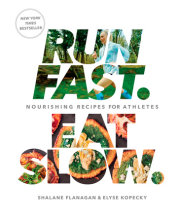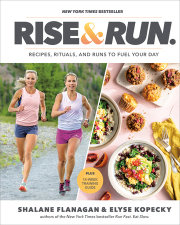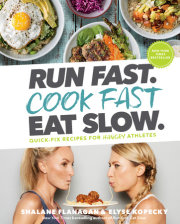As runners we are so focused on our immediate energy needs that we obsess over macronutrients and forget that not all proteins, fats, and carbs are created equal. The stress that running puts on the body means that to stay healthy, runners need more antioxidants, vitamins, and minerals than most. In a culture accustomed to processed foods, produce shipped from halfway around the world, and factory-farmed meats, it's more difficult than ever to fulfill our nutritional needs. As a result, runners everywhere are missing out on the nourishment their bodies need to thrive.
The chance to teach endurance athletes like you how to nourish your body for the long run is what inspired us to pour our hearts into this book. We aren't suggesting you eat this way solely to crush your PR or to cross the finish line first. This book can help you do just that, but we're also looking past the finish line and aiming for lifelong health and happiness.
Before you dive into our recipes, we want to impart some of our healthy- eating wisdom. For us, deciding what to eat, in order to eat well, has become second nature--a way of life. But to many of our fellow runners, our way of eating might at first sound foreign and daunting. Fear not. You're about to discover that our approach to maximizing nourishment so that your body can perform at its best puts flavor and fun at the forefront.
We all know what "run fast" means, right? Get out there and kick some @#*! We want you to be able to do just that and more. In a broader sense, "run fast" means not just surviving but thriving in our insanely fast-paced lifestyles--lifestyles that don't seem conducive to having the time (or energy) to cook. We'll convince you otherwise!
But what do we really mean by "eat slow"? It means so much more than simply taking the time to chew your food. It represents our way of eating that includes preparing nourishing meals from scratch, sitting down at a table instead of eating on the go, enjoying food in the company of friends and family, seeking out foods that were grown or raised with care, and tuning in to what our bodies need to thrive.
RUNNING ON EMPTY
Despite all the medical discoveries over the last 50 years, humankind is far from thriving. In fact, we are less healthy today than our grandparents. For the first time in history, children born today potentially have a shorter life expectancy than their parents. Occurrences of chronic diseases like cancer, heart disease, diabetes, and depression are at an all-time high. Studies show that unhealthy diets are a leading cause of these preventable diseases.
Although runners are put on a pedestal as the epitome of health, we know all too well that runners and other endurance athletes are far from immune to these serious health issues. The convenience foods coveted by runners, including bars, gels, and sports drinks, not only lack real nutrition, but also are high in inflammatory foods like refined grains, processed sweeteners, industrial oils, and artificial ingredients.
There are more than 600,000 food items in the marketplace today: 80 percent of them have added sugar, and the majority of packaged foods are nutrient poor and contain chemical additives. Scary, considering that for most Americans, packaged foods make up 70 percent of their diet.
As a result of our reliance on nutrient-poor processed foods, the majority of Americans are overfed, undernourished, and running on empty. Refined foods provide mass without sustenance. For an athlete, running on empty can lead to immediate negative consequences and long-term health concerns.
On top of this, runners are constantly bombarded with messages about weight loss, calorie counts, juice cleanses, low-carb diets, low-fat diets--the list goes on. These messages lead to an unhealthy relationship with food, imbalanced eating, food phobias, obsessions over weight loss, yo-yo dieting, cravings, undernourishment, weight fluctuations, and eating disorders.
It is estimated that at least half of the running population is sidelined at some point during the year due to an injury. The right nourishment can help an athlete recover from injury. Food can be incredibly healing, but the Standard American Diet (SAD) is high in inflammatory foods and low in healing foods. For an athlete who is constantly breaking down the body during intense training sessions, nutrient-dense foods are critical to a faster recovery time.
According to Ron Thompson, PhD, FAED, CEDS, coauthor of Eating Disorders in Sport, "When coaches and athletes are asked what is the major contributor to good athletic performance, they often say things like VO2 max, training load, or a particular type of training. Such factors are important in sport performance, but with such responses, athletes and coaches are missing the basics. Other than genetics, the major contributor to good athletic performance is good health, and the major contributor to good health (other than genetics) is good nutrition. The well-nourished athlete will not only perform better, but will perform better longer."
With so much misleading information out there--most of it driven by food corporations--it's no surprise that something as basic and intuitive as eating has become so complex. The result of being bombarded with food products everywhere we turn is that we're no longer in tune with one of our most basic needs: eating. We have lost the instinct to reach for the foods that will best fuel our demanding lifestyles.
INDULGENT NOURISHMENT
"Indulgent nourishment" is how we define our way of eating. We know our hardworking bodies need substantial fuel, so we indulge in our favorite whole foods. By filling up on the healthful foods we love and not obsessing over calorie counts, carbs, or fat, we're able to eat in tune with what our bodies need. We know that real food leads to serious satisfaction and allows the body to function optimally without weight gain.
On the other hand, we believe that dieting leads to imbalanced eating, which results in sugar cravings, snack attacks, and, in the end, weight gain. Instead of focusing on calorie counts, we focus our energy on eating a balanced diet rich in wholesome foods--foods that keep us energized and satisfied.
The recipes in this cookbook do not include calorie counts or macronutrient (carbs, protein, fat) measurements. This wasn't an oversight but intentional. Don't ask us how many grams of protein are in our High- Altitude Bison Meatballs with Simple Marinara (page 120) or how many grams of fat are in our Superhero Muffins (page 42). We don't know and we don't care. Instead we'll tell you all about the incredible phytochemicals, antioxidants, and omega 3s and the exciting ways these delicious foods can help supercharge your training.
All macronutrients are not created equal. Judging the health of a food based on how many grams of protein or fat it has is dangerous because these numbers don't reveal the nutrient quality of the food. It's akin to buying a pair of running shoes based solely on their weight without looking at the quality of the technology or considering how the shoe feels on your foot.
EATING REAL FOOD
When deciding what to eat to eat well, it's best to look at the full picture, including where the food came from, how it was grown, how much it was processed, how it tastes, and, most important, how it makes you feel.
For us that means eating a varied diet that includes meat, veggies, fruit, cultured dairy, legumes, whole grains, nuts, seeds, and more. We avoid processed foods and limit our consumption of refined grains and sugar-- these foods don't make us feel good. We seek out organic and local ingredients as much as possible and enjoy eating with the seasons, since food picked at its peak not only tastes better, but also is more nutrient dense.
We don't eat meat every single day, but we do believe it is healthy to include on a regular basis in our diets. In many of our dishes, the veggies shine and meat becomes the loyal side companion. As much as possible, we try to get our meat from trusted local farmers who care about the planet. The free-range chicken, beef, bison, and lamb we buy is expensive, but our philosophy is to eat better quality meat and less of it for maximum nourishment.
Not everyone can afford to buy organic all the time, but when possible try to stick to organic, local, or sustainable options when it comes to meat, seafood, dairy, and the produce on the Environmental Working Group's "Dirty Dozen" list (annual list of the most pesticide-ridden produce). Consider ways to make budget cuts elsewhere to make good food a priority. In the United States, we spend less on food than any other developed country, a mere 6.4 percent of our total spending, and we spend more than any other country on health care. Spending at the grocery store or farmers' market is an investment in your future.
We hope you'll find this to be a refreshing way to eat. If you're eating mostly whole foods, you don't need numbers to eat healthy and balanced. But it might be difficult to let go of the numbers at first and get in tune with your body's hunger signals. In our society, we're programmed to think of food in terms of calories or cost (negatives) instead of in terms of nourishment and satisfaction (positives). Slowing down, taking the time to cook, and enjoying every bite will help.
FAT FOR FLAVOR AND FUEL
In our recipes, we make no apologies for the amount of fat. We sauté with olive oil, bake with butter and coconut oil, stir in whole milk yogurt, simmer with coconut milk, and drizzle on dressings and sauces.
Why?
Fat is a carrier for flavor and nutrients. Many vitamins and minerals cannot be absorbed without it. Fat is also a primary source of energy-- viable energy that can fuel your body for endurance endeavors. A meal rich in healthy fats will leave you feeling satisfied, better nourished, and less likely to reach for a sugar fix.
Runners often obsess over carbohydrates and protein and forget that fat is also an important building block. Both saturated and unsaturated fat from whole foods is critical for healthy brain function, cardiovascular strength, hormone balance, building lean muscle, and combating inflammation. Studies show a diet rich in good fats actually boosts metabolism instead of causing weight gain.
Female athletes in particular can suffer hormone imbalances without enough fat in their diets. It's estimated that 20 percent of active women and up to 45 percent of female competitive runners suffer from athletic amenorrhea, which can lead to bone loss and fertility issues. When the body isn't getting enough fuel, it begins to shut down systems that aren't necessary for survival, and the female reproductive system is one of the first to go. Getting more high-quality calories in the diet can reverse this detrimental condition.
The fats we love for their health-giving properties and ability to transform the mundane into magic include nuts, seeds, avocados, coconut oil, olive oil, whole milk yogurt, meat, and butter (learn more about these fats in Chapter 2).
On the other hand, the oils found in packaged and fast foods are often unhealthy hydrogenated fats made in a lab via a harsh chemical process to give them a long shelf life. These inflammatory fats don't have any health- redeeming properties and are stored by the body instead of burned as fuel, leading to weight gain and an increased risk of heart disease. Not cool.
We've been programmed to think of fat as bad, but remember that not all are created equal. The fats we use in the recipes that follow are body-loving, nutrient-dense, energizing fats.
Health food unfortunately has gotten a bad rap over the years for being bland and boring. It doesn't have to be. There's a wealth of nutrients in a range of your favorite foods (and no, they're not just vegetables!) that you'll be thrilled to discover in Chapter 2 as we take you on a tour of our pantries.
EAT LIKE SHALANE
Without measuring calories, you might wonder how Shalane achieves her optimal race weight. Shalane does make a conscious effort every single day to eat fresh, whole foods, but she doesn't follow a diet plan. She would rather save her mad math skills for counting miles and calculating splits. She avoids processed foods and sugary snacks because these foods provide little sustenance and displace the real foods her body craves.
Leading up to a big race, Shalane will limit her consumption of sweets and give up her occasional glass of wine. Otherwise she eats like she always eats--with an appetite for nourishment and an appreciation for good food.
Since Shalane started devouring the recipes in this book, her ideal racing weight now comes naturally, without deprivation. She no longer craves sugary snacks, and she feels satisfied after every meal. This has been a refreshing game changer, allowing her to have fun in the kitchen. She now views cooking as a training tool that's as important as her next workout.
To help you make the transition to a balanced whole foods-based diet, we've provided an outline of what a typical week of eating looks like for Shalane. We've included cross-references to the recipes in this book that she can't live without. We've also listed her go-to recipes for fueling for race day, including what she eats the night before and the morning of her big marathons.
It's important to remember that different foods affect everyone differently. You should always listen to your own body and eat what makes you feel good. Never try anything new the night before or on race day. Practice eating new foods before your training runs and learn what you digest best.
MARATHON-READY FAVORITESPrerace Dinner:Flu-Fighter Chicken and Rice Stew, page 108
High-Altitude Bison Meatballs with Simple Marinara, page 120
Wild Salmon Sweet Potato Cakes, page 142
Parmesan and Herb-Crusted Cod, page 150
Sweet Potato Fries, page 161
Marathon Day Breakfast:Race Day Oatmeal (with banana, nuts, raisins), page 53
Toast with homemade nut butter (Sweet Cinnamon Tahini Butter, page 204, or Coffee-Vanilla Peanut Butter, page 205)
Coffee
Hydration drink
Postrace Celebration:Don't Get Beet Hummus, page 73, with Pita Chips with Oregano and Sea Salt, page 74
Greek Bison Burgers, page 138, with Avocado Cream, page 178
Oregon microbrew
Doughnuts . . . shh, don't tell
Flourless Almond Torte, page 184
Copyright © 2016 by Shalane Flanagan and Elyse Kopecky. All rights reserved. No part of this excerpt may be reproduced or reprinted without permission in writing from the publisher.






